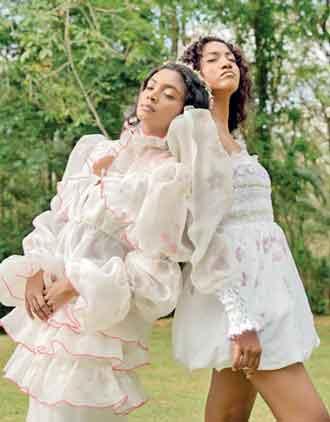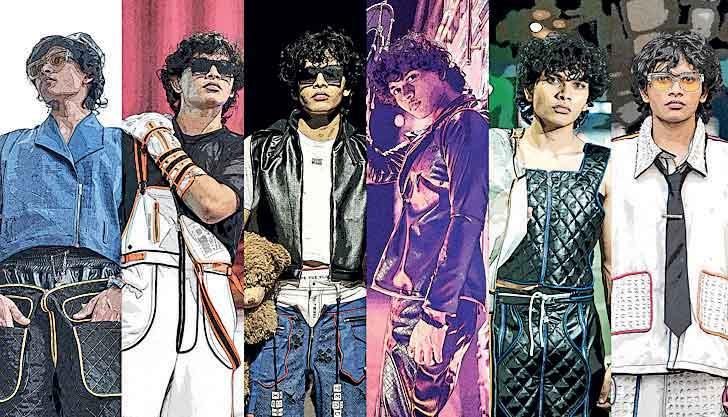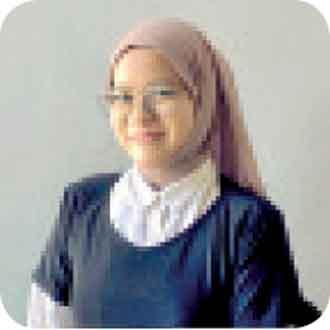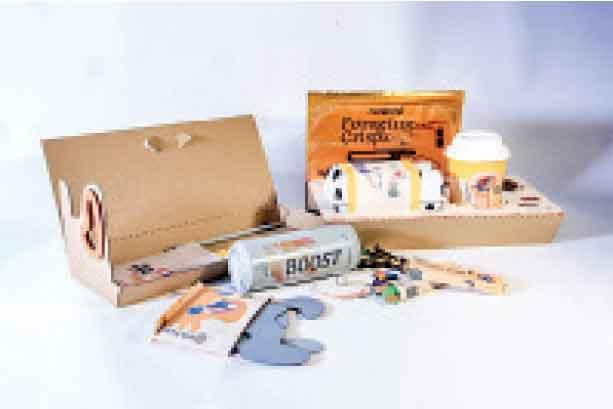07 Nov 2024 - {{hitsCtrl.values.hits}}

 Today marks the four day extravaganza of workshops and fashion shows which will be held at Cinnamon Life. The SLDF and MBFWSL provide perfect platforms for students of the AOD to showcase their creativity. Sealing their reputation as a hot house for generating new talent in all aspects relating to design, the AOD each year continues to reveal new talent who go on to contribute their might to Sri Lanka's burgeoning design industry. Here a cross section of students share their stories on their perspective on design.
Today marks the four day extravaganza of workshops and fashion shows which will be held at Cinnamon Life. The SLDF and MBFWSL provide perfect platforms for students of the AOD to showcase their creativity. Sealing their reputation as a hot house for generating new talent in all aspects relating to design, the AOD each year continues to reveal new talent who go on to contribute their might to Sri Lanka's burgeoning design industry. Here a cross section of students share their stories on their perspective on design.
 01.Q: What unique inspirations influence your designs, and how do you incorporate elements of your heritage into your collections?
01.Q: What unique inspirations influence your designs, and how do you incorporate elements of your heritage into your collections?
02.Q: Sustainability is becoming a crucial part of the fashion industry. What steps are you taking to create eco-friendly and responsible fashion?
03.Q: Are there any traditional crafts or techniques that you aim to preserve or revive in your work, and how do you incorporate these elements into modern design?
04.Q: As an emerging designer, how do you balance creativity with the practical challenges of establishing your brand in a competitive industry?
 Samadhi Peiris
Samadhi Peiris
Age : 20
Place of education : AOD Colombo,
Northumbria University, New Castle
Fashion Design and Marketing department
01.My designs are inspired by the beauty and resilience of South Asian dark-skinned women, particularly those who have faced colourism and discrimination. Their stories profoundly influence my brand, Melanin, and each piece is a celebration of their identity and experiences. I aim to showcase the beauty of darker skin tones through colours and textures that accentuate and complement them, promoting self-love and self-acceptance.
 Heritage is woven throughout the brand, as I incorporate traditional Sri Lankan techniques like beeralu lacework, patchwork, and hand-smocking, blending cultural craftsmanship with contemporary silhouettes to create garments that are both timeless and modern. The initial collection explores the delicate emotions of girls subjected to colourism, expressed metaphorically through colour, texture, silhouettes, and prints. Additionally, I choose skin-friendly fabrics like cottons, linens, and silks, which not only feel luxurious but offer healthcare benefits for the skin. This thoughtful selection of materials aligns with Melanin’s ethos, emphasising both beauty and well-being.
Heritage is woven throughout the brand, as I incorporate traditional Sri Lankan techniques like beeralu lacework, patchwork, and hand-smocking, blending cultural craftsmanship with contemporary silhouettes to create garments that are both timeless and modern. The initial collection explores the delicate emotions of girls subjected to colourism, expressed metaphorically through colour, texture, silhouettes, and prints. Additionally, I choose skin-friendly fabrics like cottons, linens, and silks, which not only feel luxurious but offer healthcare benefits for the skin. This thoughtful selection of materials aligns with Melanin’s ethos, emphasising both beauty and well-being.
02.Sustainability is essential to Melanin. I use eco-friendly practices such as eco-printing with local plants and natural dyes, and I work with local artisans to bring my vision to life, creating fully handmade pieces with artisanal techniques, even including handmade buttons. This approach makes Melanin an ethically produced brand.
03.I’m passionate about preserving traditional Sri Lankan crafts like beeralu lacework, patchwork and hand-smocking, which bring character and depth to each garment. By combining these techniques with clean, modern lines, I create designs that honour heritage without feeling outdated. Each detail becomes a bridge between the past and present, showing that these crafts can be timeless in a modern context.
04.Balancing creativity with practicalities is challenging but rewarding. Staying focused on Melanin’s mission which includes uplifting South Asian women and promoting inclusivity will help guide every decision. I aim to keep my collections small and focused, emphasising quality and thoughtful design to stand out in the industry. Building a community around these shared values also will help Melanin grow with intention and resilience, allowing creativity to flourish within a sustainable business model.
 Chanali Ranathunga
Chanali Ranathunga
Age: 20
Place of Education: Academy Of Design (AOD)
01.The Agni collection is deeply inspired by the story of King Ravana and the captivating Kathakali dance. "Agni," symbolizing fire and strength, serves as both the aesthetic and thematic core of the collection. By drawing from these powerful cultural symbols, my designs honour my heritage through the bold use of colour, structure, and intricate embellishments that mirror traditional artistry. Each piece in Agni seamlessly merges cultural motifs with contemporary shapes and details, creating a vibrant fusion that resonates with today’s young women, reflecting both tradition and modernity.
02.In the Agni collection, sustainability is integrated through thoughtful material choices and design techniques. We prioritize fabrics like handwoven cotton and sustainable silk, focusing on materials with lower environmental impact. The patchwork approach is itself a sustainable practice, as it allows us to use smaller pieces of fabric effectively, minimizing waste. Additionally, each garment is crafted with longevity in mind—built to endure and stay relevant, allowing wearers to enjoy their pieces season after season.
03.Absolutely. Traditional crafts like intricate embroidery, beading, and appliqué are central to the Agni collection, connecting each garment with South Asian artistry. Inspired by Kathakali and Ravana's symbolic power, these details not only bring authenticity to the collection but also celebrate the skilled craftsmanship behind each piece. By combining these traditional techniques with contemporary silhouettes, I aim to keep these crafts relevant, allowing a new generation to appreciate them in modern contexts.
04.Balancing creativity with the realities of the industry requires strategic thinking and adaptability. While the Agni collection is rooted in a strong cultural narrative, I focus on creating designs that are both visually striking and wearable. This dual focus helps to connect with a modern audience while still honouring the collection’s deeper themes. In a competitive space, I strive to differentiate my brand through unique storytelling and a commitment to cultural and sustainable values, all while making thoughtful decisions to ensure that the business side supports my creative vision.

 Dona Thathiana
Dona Thathiana
Age : 22
Place of education: Nugegoda Sujatha Vidyalaya , AOD
01. As a designer I believe my muse is my own self and my own thoughts. I rely on my inner self to draw out inspiration and I map it out on a canvas as a piece of artwork. Each project has its own artwork that takes becomes the project vision. The next steps of each projects goes based on the initial artwork. Currently my main influence for my creative journey’s would be my memories related to my inner child. As of heritage I mainly focus on crafts such as crochet,, embroidery and lace. The idea of inner child is a form of heritage in an of itself.
02.My take on sustainability follows the concept of quality over quantity. The concept of quality falls not only in the piece of clothing that I make but also in the design process, production process and also with the communities involved. A topic that’s less discussed when it comes to sustainability is community building and as a designer my main focus relies on that. I bring in people of like minds together to bring back the people element thus creating strong loyal groups that somewhat drives towards a common goal.This way as a fashion brand or as a personal brand the quality of the work that’s put out remains ethical and sustainable.
From a design perspective I follow a zero waste production process to the best of my abilities. From designing to pattern cutting to the final outcome. All the waste materials that ends up at the end of the production cycle gets sent to be crushed into pieces to use as fillers for plushies . That is one of the methods I use in order to maintain zero waste projects. That way I can ensure the sustainability of my projects.
03.My work focuses more on art and community. I wouldn’t pinpoint on a specific craft or technique as an enjoy exploring what small Sri Lankan communities has to offer. I involve
people of these communities in my production processes by learning their knowledge and techniques and possibly carrying them to the rest of the world and give these communities the credit that they deserve. I like to refrain from the term modern when it comes to design simply because I like to keep my designs timeless. It is for whomever sees it fit especially my brand Teddy Winks focuses on marketing for a wide community not limited to age or gender.
04.I believe it all depends on one’s problem solving skills which also does require creativity. Facing challenges during projects requires creativity to be solved. Creativity and challenges work hand it hand naturally following a balanced state. If I were to balance creativity from an outside standpoint with practical challenges I believe it comes down to unlearning old things and learning new things in order to keep the momentum. It is true that the industry is competitive which is why proper research guides me to the right path. Among all that, flexibility is key in order to survive as a brand.

 Onethra
Onethra
Gunathilaka
Age: 20
Place of education: Academy of design
01.The process of being inspired comes naturally to me. I always look inward and draw from the rich background I was raised in. Buddhist philosophy is a constant source of inspiration, influencing many of my designs, including my final major project, 'NOESIS,' and previous collections like 'Hz' and 'Anitya' from my second year. Heritage is truly the heartbeat of my design process. I bring together textures, colours, and motifs unique to my culture with my personal identity, aiming to weave a piece of my heritage into every collection while embracing my own narrative.
02.As a designer, I see sustainability as both a responsibility and a creative challenge. I'm committed to mindful material choices, favouring eco-friendly fabrics, and working closely with ethical suppliers to ensure ethical production practices. But most importantly I focus on timeless designs that encourage longevity over fast fashion, aiming for pieces that resonate beyond mere seasons. In my collections, I explore efficient pattern-making techniques that minimize fabric waste. For me, sustainable fashion is about crafting with intention, creating pieces that honor both people and the planet.
03.I’m passionate about preserving traditional crafts and seamlessly weaving them into contemporary design. I enjoy reimagining these techniques in a modern context—for example, blending traditional embroidery with digital printing on minimalist silhouettes, or combining the batik technique with laser cuts inspired by today’s aesthetics. For me, it’s all about creating a dialogue between past and present, so that each piece carries forward a sense of heritage while resonating with a modern audience.
04.As an emerging designer, I see creativity and practicality as two sides of the same coin. Creativity drives my vision and purpose, while practical challenges shape it into something real, sustainable, and wearable. I’m focused on designing collections that not only stand out but also embody my brand values of timelessness and sustainability. My goal is to create pieces that balance artistic expression with a deep understanding of what resonates in the market, making each design both distinctive and purposeful.

 Sahar
Sahar
Age: 20
Place of education: AOD
01.The core of my design inspiration lies in storytelling. Every design idea I develop begins with the question: What story do I want to tell, and what emotions do I want people to experience as they move through each space? I focus on creating a journey through materials, spatial hierarchy, and flow, ensuring that each area connects seamlessly. My final major project embodies this approach. with each floor contributing its own chapter to a cohesive, impactful narrative. While cultural heritage doesn't play a major role in my designs, as my background has been quite mobile, my focus remains on universal emotions and experiences that resonate across diverse audiences
02.I incorporate sustainability in my designs through biophilic principles, focusing on how nature can resonate within a space to evoke a sense of its magic. I use complex, multilayered structures with asymmetrical, organic curves that reflect biophilic qualities, allowing people to feel more connected to the natural world.
03. My brand is all about challenging expectations. I’m more capable than I may seem, and what I bring to the table often goes beyond what’s expected. I dream big, which means my designs are ambitious and unbound by convention. This approach fuels my drive to push through the competitive industry. I'm eager to continue my journey as a designer, learning practical, functional techniques and applying that knowledge.

 Shehan Jude Fernando
Shehan Jude Fernando
Age - 22
Place of Education - Academy of Design
01. As a storyteller and animator, my main inspiration is the unique and colourful cultures found in Sri Lanka. Many of these cultural tales and identities can be lost in translation for a modern audience. This mediation between time and people is what I strive to incorporate in my designs.
02. When it comes to materials used in an experimental animation or even for a live-action film, it is important to be sustainable. Selecting materials that are environmentally friendly and having a low impact on the environment and also considering ways to reduce fabric waste, such as training on how to reduce mistakes and repurposing fabric waste, is important.
03. When working with modern techniques in the animation industry, it is vital to use certain traditional stylized techniques that add a certain attraction and specialty to the designs. Techniques such as Rotoscoping, traditional frame by frame animation and reference recording can be such useful elements.
04. When it comes to branding, many artists tend to market a distinctive identity of themselves. As an emerging designer I strive to combine the local styles and visuals with the practical challenges proposed by the industry. I strongly believe that the stories and moments we explore could be told to the future generations of designers.

 Dulana Ethugala
Dulana Ethugala
Age - 23
Place of education - Royal College / AOD
01.I tend to be fascinated by what might seem mundane for most people, like seeing simple hand written signs on the side of the road, makes me want to stop and take a picture. I have a habit of observing and trying to figure out how things work, and why are they the way they are, these creative detours might not seem significant at the time but they form a library of content and ideas in my head which I can easily refer to and synthesize when I work on projects. I'm also an avid fan of stories, folk stories, myths, history, people's life experiences...
02.Being a visual communicator, all my projects have been tied to different sustainable development goals. One thing I try to highlight in my work is being "sustainable." It isn't as simple as eco-friendly material. Sometimes so-called eco-friendly materials used in the wrong context can be less sustainable, hence it is important for us as designers to create holistically viable solutions. One of my personal philosophies is that it is a designer's responsibility to create convenient sustainable practices for the general public.
03. I’m keen on discovering knowledge systems that are embedded into local culture and traditions. As Sri Lankans we inherit a vast wealth of heritage, that most of us ourselves don’t know what to do with it. My final year project I embarked on a journey to discover how I can contribute to preserve this rapidly vanishing knowledge bank. Along my pursuits I realized culture isn’t something you can keep in a box, sealed and preserved. Culture thrives in transmission, being shared among people, communities, generations.
04.Even though it is called the creative industry, many jobs in design have creatives in a chokehold with budgets, deadlines, client tastes and requirements etc. We need to live with this reality to thrive in this industry, The way I see it, it’s these constraints that makes us designers. As much as creativity is one of our strongest tools, it’s the problem solving to get around these practical constraints that differentiate us from artists.

 Ruwini Wijetunga
Ruwini Wijetunga
Age - 23
Place of education - Lyceum International School Nugegoda
AOD Academy of Design Sri Lanka
01.My inspiration was the tropical fruits and street shops of Sri Lanka, unique in their own colourful way, establishing a ritual of Sri Lankan daily life. Choosing these elements was all about reminiscence, as part of what the Sri Lankan Diaspora misses from their lives, which I have included in my designs through colourful and eccentric winter wear. It is further incorporated by batik craftsmanship and knitting artisanal pieces to bring in the colours and comfort to the collection.
02.In terms of sustainability, my personal belief is re-using what we have already got. For more responsible fashion, I made sure I re-used scraps of the collection fabric to incorporate to my shoes, leftover fabric from my previous first and second year collection to my knitting pieces. Making new things with leftovers is always cool, and I have practiced this in my life since childhood. It has always been like a ritual thus the name for my brand. YAAGA
03.The main techniques of craft I've used are batik and knitting. I believe that Sri Lanka can be very contemporary with both these methods, as I have done batik in corduroy, using my own print design as a guideline for the artisans, and colour balancing according to my colour pallette. When it comes to knitting, I explored it in terms of different yarns in a mix, as well as different knit stitches coming into play, which actually could be done in very commercial pieces as well. Incorporating all these elements is mostly about placing them, according to research, experiment, trial, errors and final execution, according to the garment silhouette planned.
04.Well, the industry does look for more creatives don't they? I believe creating a balance with creativity and practicality, proper planning and having a proper understanding of the market one is serving in, success and creativity will be achieved. Collaborating with other brands to achieve cohesive competition, would further strengthen the brand establishment and long-term rapport with other creatives.

25 Dec 2024 3 minute ago
25 Dec 2024 20 minute ago
25 Dec 2024 34 minute ago
25 Dec 2024 59 minute ago
25 Dec 2024 2 hours ago